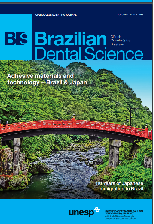Non-thermal plasma increase bond strength of zirconia to a resin cement
DOI:
https://doi.org/10.14295/bds.2018.v21i2.1562Resumo
Objective: This study investigated the influence of different surface treatments on zirconia surface energy, roughness and microshear bond strength. Material and Methods: Forty eight slices of Yttria-stabilized tetragonal zirconia polycrystal (Y-TZP- VITA In-Ceram® YZ for inLab®) (6.4 x 3.2 x 1.6 mm) were divided into 3 groups according to the surface treatment (n = 16): YTZP_control -untreated; YTZP_plasma -surface treatment with non-thermal oxygen plasma; YTZP_primer - coating with ceramic primer. Surface energy (n = 6) was measured with a goniometer; and surface roughness (n = 10) was analyzed with a 3D profilometer were performed over zirconia surface. On the same specimens of surface roughness, on the treated zirconia's surface, resin cement (PANAVIA V5 - Kuraray Noritake Dental) was built up by inserting the resin cement into Tygon tubes (1 mm of internal diameter X 1 mm length). After 24 h storage, microshear test was assessed. Data were analyzed by one-way ANOVA and Tukey post-hoc test (p < 0.05). Results: Non-thermal oxygen plasma treated specimens exhibited higher statistically significant surface energy (p = 0.00) and bond strength (p = 0.00) when compared to control and primer groups. Roughness test (p = 0.897) could not detect statistical difference among the tested groups.
Conclusion: Non-thermal oxygen plasma should be a suitable alternative for zirconia surface treatment prior to luting hence it improved microshear bond strength and provided higher surface energy without affecting surface roughness.
Keywords
Adhesion; Non-thermal plasma; Surface treatment.
Downloads
Downloads
Arquivos adicionais
Publicado
Como Citar
Edição
Seção
Licença
TRANSFERÊNCIA DE DIREITOS AUTORAIS E DECLARAÇÃO DE RESPONSABILIDADE
Toda a propriedade de direitos autorais do artigo "____________________________________________________________________" é transferido do autor(es) para a CIÊNCIA ODONTOLÓGICA BRASILEIRA, no caso do trabalho ser publicado. O artigo não foi publicado em outro lugar e não foi submetido simultaneamente para publicação em outra revista.
Vimos por meio deste, atestar que trabalho é original e não apresenta dados manipulados, fraude ou plágio. Fizemos contribuição científica significativa para o estudo e estamos cientes dos dados apresentados e de acordo com a versão final do artigo. Assumimos total responsabilidade pelos aspectos éticos do estudo.
Este texto deve ser impresso e assinado por todos os autores. A versão digitalizada deverá ser apresentada como arquivo suplementar durante o processo de submissão.




























